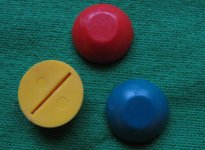

| Peter Upton's |
Subbuteo Tribute Website. |
|
Old Figures - New Games. |
|
Subbuteo Clones Introduction. |
Whilst the name Subbuteo is an established trade mark, the type of table football game it represents has a history that is a bit more complicated. You could make a case that Subbuteo itself was a clone of Newfooty. You could also argue that Newfooty was a clone of earlier games played with bottle tops (see the wonderful Ligafutbolchapas.com for details).
What is certain is that the Subbuteo patents from 1947 have long since expired and rather like Lego, modern Subbuteo has to compete with any number of similar rivals. The idea of these pages is to look at all the alternatives for the modern player and/or collector. However, I thought I would start with a little history of "cloning" before we hit the modern day. Some of this history is taken from other parts of the site, but it is useful to bring it all together.
Cloning the Flat Game 1960s-80s.
The Success of Subbuteo in the 1960s and 1970s was really kick-started with the introduction of the attractive OO scale players and accessories in the early 1960s. However, inventor Peter Adolph was aware that there were many players who enjoyed the game using his perfectly balanced flat players (whether celluloid or card), and that in general the serious adult players preferred this style of play. So he continued to make and sell this range alongside the new "Continental" style. When the company was taken over by Waddingtons in the late 1960s, the writing was on the wall for this niche product, and the range was phased out.


This understandably caused some anguish to the serious minded playing community, no more so than with The English Table Soccer Association. As recounted in my History of Competitive Table Soccer, the ETSA members clubbed together to buy a mould to produce their own bases, and later produced blank players to go into them as well. Subbuteo Sports Games did challenge this at the time - but it didn't come to anything.

The table soccer playing community later refined their own range, and the "Swiss T" was born. The Independent Subbuteo Forum has a little more details on this. The products were produced by the SSTV (Schweizerische Subbuteo Tischfussball Verbund). They started with bases (apparently they have SSTV in raised letters on them), then produced card figures in a plain all-white kit for colouring, and balls in the large "size F". Their final product was a top quality baize pitch. Sadly, they never put it all together into a box set....
Whilst I would like to credit the ETSA for being first out the blocks with a proper Subbuteo clone..... I don't think they were. This is because there is this very strange Spanish game from the late 1960s, that might just tie in with the Spanish Subbuteo factory that had existed in the Peter Adolph era.
Mini Sports No 1 Football. (Spanish clone from the 1960s).
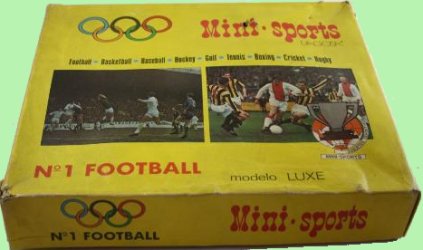
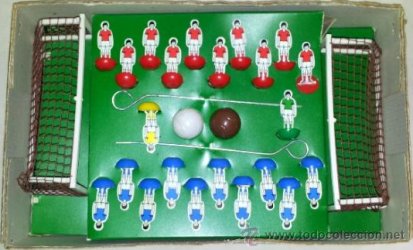
Spanish Subbuteo historian Jorge Vila pointed me in the direction of this weird little set. Although the box has a number of different sports listed, Jorge is pretty sure that sport No 1 Football, was the only release. The pictures here are "borrowed" from a Spanish auction site.
The game has at least two versions, "Standard" and "Luxe". The interior picture shows that the goals (and maybe the goalkeeper rods and balls) are original Subbuteo products. Jorge is not yet sure how this relates to the story of Subbuteo production in Spain in the 1960s. The Mini Sports game seems a little later in date to the Spanish Subbuteo range, but the manufacturer is from the same area of Spain. Perhaps they acquired some of the old stock?
Looking at the other theoretical sports on the lid of this set (Basketball, Baseball, Hockey, Golf, Tennis, Boxing, Cricket and Rugby), you can speculate on how well a cricket game would have sold in Spain, or perhaps how a Subbuteo style boxing game might have worked. Subbuteo martial arts - Flick to kick.... and punch.
Calcio Gol - by Ellegi (Italian clone from the 1970s).
Pelebol expert Pasquale Carrassi has come up trumps once again, with this Italian Subbuteo rival/clone, which I've never seen.
CALCIO GOL, was produced by the Italian company ELLEGI. Pasquale explains that it was quite popular in Italy in mid seventies as a cheaper rival of Subbuteo. He tells us that Subbuteo was the best table soccer game, with this game as the second choice, and the Atlantic game (shown in my rivals section) being the cheapest and worst of the three.

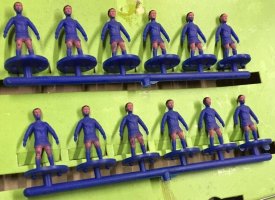
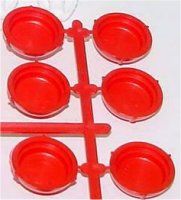

The Calcio Gol figures are very clearly based on the moulded Scarecrow figure from the early 1970s Subbuteo box sets. The key thing though is that the figures were almost double the size of the Subbuteo version. However, when it comes to table soccer, bigger is certainly not better (as any Sport Billy owner will tell you). In addition, the plastic used by Ellegi, and the general finish was certainly a step down from Subbuteo. Whilst the players were bigger than Subbuteo, the ball was smaller. A more realistic proportion perhaps, but this tends to only allow for a Fivesides style of game - i.e. chipping the ball gets impossible. Oddly, the balls had a washer inside, as did the bases of course. In neither ball or figure were these washers glued, so everything sounded like a Subbuteo "rattler" when playing the game. That is never a good thing....
The players in the cheaper editions of Calcio Gol came unpainted in different colour plastics (like the equally cheap looking Grandslam game). In addition, the players and bases were sold still on their sprues, so assembly was necessary. The goalkeeper (another Subbuteo copy in a giant scale - this might be useful!) was moulded onto a square base, and had a metal handle.
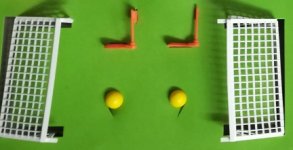
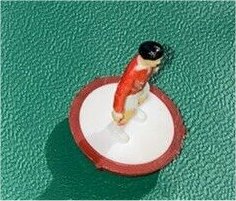
The corner flags look similar to the 1970s Subbuteo equivalent, with their triangular chipping bases. The goals were a single plastic piece, but quite effective. The main problem was the pitch. A pitch could be the most expensive item in a table soccer set, but it was also the most important. Subbuteo sets got this right. Calcio Gol got it wrong - a cheap dimpled plastic pitch on which the ball was going to run and run (even with a washer to slow it down). The close-up above hopefully shows the material used. The pitch came rolled-up.
The box sets available were :
Il Super Calcio dei grandi derby.
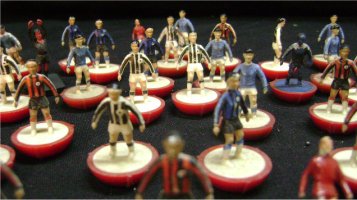
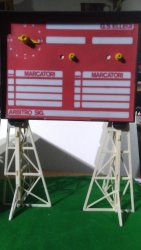
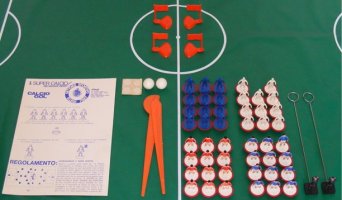
This was top of the range. It included two painted teams like Milan and Inter or Juventus and Torino (i.e. for Derby matches…), both of which had twelve players. Also included was the pitch made of a thin nylon plastic, two plastic goals, a Cup, two balls, and four corner flags. There was also a strange tool, a sort of orange compass used to measure distances on the free kicks - which you can see in the above picture.
Pasquale advises that the best gadget in the set was a huge, very nice electronic scoreboard including a real digital timer working on batteries. He points out (rightly) that this is a real digital scoreboard, not a "fake" one like C158! This digital scoreboard helped make the deluxe edition quite pricey, at 12.500 old liras.
Calcio Gol Edition.
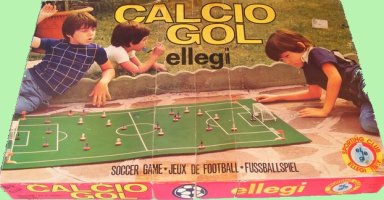
This was the standard set. This cheaper version included everything from the Derby set except the super scoreboard. Half the price though, just 6.000 liras. That shows that the scoreboard was a seriously expensive item.
Under 23 Edition.


This was a budget set with two un-painted teams, also in need of assembly, plus the usual pitch, goals, balls and corner flags. This was half the price again - just 3000 lira.
Il Vero Piccolo Gioco del Grande Calcio.
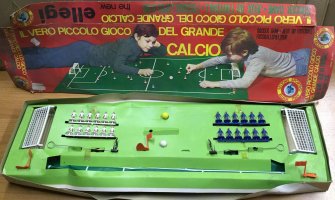
Has a big name, and a big box..... but this set was similar to “Under 23”, with the only difference seems to be that the two teams have their flesh painted, plus a display box. Perhaps an earlier version?
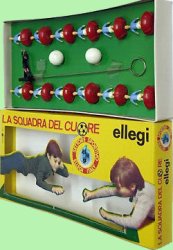

Individual teams were also available for 1500 liras (called “La Squadra del Cuore”). These reproduced most of the main Italian serie A sides - Napoli is illustrated. These were sold in an attractive box, and the inner tray was just like a Subbuteo one, making allowance for the size of the players and the presence of two spare balls.
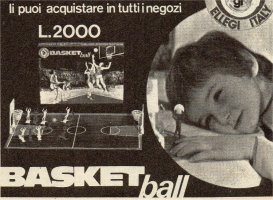
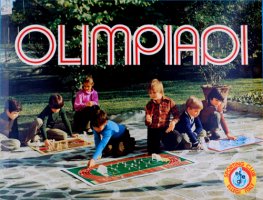

Beside their Football game, the Ellegi sport division also produced a Basketball table game (2000 lira according to the advert), and sold a box set called Olimpiadi, including different sports (football, basketball, water polo, swimming and athletics). We don't have a lot of details on this one, but I have blown-up the appropriate part of the box lid, so you can hopefully see the different pitches, and the kid flicking a runner around the track.....
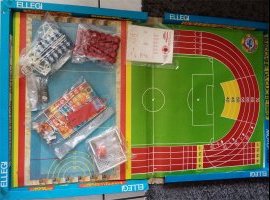
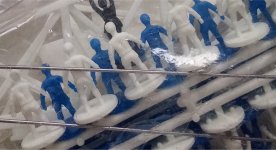
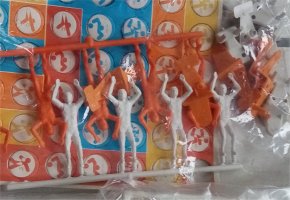
April 2022:- Sports board game collector Joerg Streitberg kindly provided some large photos of his unused Olimpiadi set. So I've added some close-ups to highlight some of the contents. Here, you can see that the athletics stadium and small football pitch are built into the fold-out box. The football teams come unpainted in blue and white. The basketball players are very attractive, and come in orange and white. The runners and swimmers/polo players are simply round card circles that fit into the bases. It looks a really attractive set.
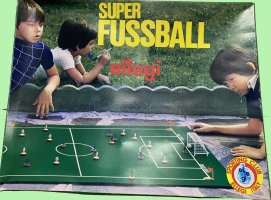
This final picture from Pasquale shows that the game did get exported into Europe. This German "Super Fussball" version corresponds to the standard “Calcio Gol” Edition. Pasquale has been told that the game was also sold in France, so perhaps that is another edition to look for.
More Clones from the Table Soccer Community.
These small scale productions were designed for improved performance in the table soccer community. Arriving in the 1990s at the dawn of the internet age, it is very difficult now to find the full details of these products, or even who was responsible for making them, despite Tom Taylor's famous Table Soccer shop stocking them well into the 2000s. None of these manufacturers branched out into full sets, but all are worthy of mention - again the playing pages have more details.
The table soccer shop also stocked Swiss T flats. These were £9.99 a set in the early 2000s, and compare favourably with the prices of some of the alternatives..
Swiss Sports Teams.
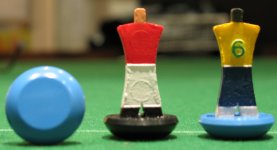

I believe that these were the first all-new figures bought to the market, arriving in 1992. They were a radical redesign, and importantly did not infringe on any Subbuteo patents that might have still been in force. Willy Hofmann, a Swiss table soccer champion helped in the design of the figures. The players are very stylistic, and made from polystyrene, making them very light. The base had the large flat bottom essential for the modern sliding game, but there was still the ability to spin these players like the flats of old. They were also quite expensive for their time, at £26.99 a set.
A similar figure was the "woodentop", a balsa wood figure made by Tom Taylor in the UK and sold from his table soccer shop, and designed to fit into the bases. A good idea, as the polystyrene figures were pretty fragile.
Toccer Figures.
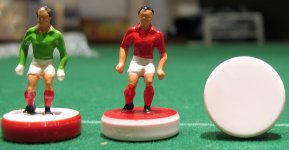
These figures were first produced in 1994, and I actually know nothing about who was making them. They were another premium product - Tom had them at £27.99 a set. The players were big, and the bases were very flat and very heavy. Again, completely different to Subbuteo products of the period. The more long-lasting innovation with Toccer were the goalkeepers, who were huge, but still within competition limits. They ushered in the era of big table soccer keepers (and like most motor car designs, a few millimetres seem to be added on to the latest model each year....)


Lunula produced two similar bases, the Sureshot and Advantage, and both were available to house lightweight or heavyweight players originally - as shown. I don't think they actually produced the figures - the table soccer shop sold them with painted or unpainted Subbuteo lightweights (and later Stefan Corda figures too). At the time, they were the cheap "professional" choice as an unpainted side could be bought for £9.99. Whilst there were premium bases being made in Italy at the time, I regard the Lunula bases as the first mass-market alternative to using standard Subbuteo bases with the standard figures. An important milestone in cloning development. These classic bases were used in the Superfooty range, and are available from The Wobbly Hobby Shop who have a supply of Tom Taylor's original stock.
And then there was Zëugo......
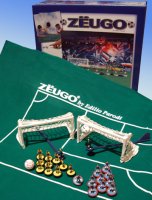
For all the small scale products shown above, the first large company to produce their own, properly named OO scale Subbuteo clone in a boxed edition was Edilio Parodi in Italy. They had been Waddingtons' official Italian distributors since the 1970s. When Habro bought Waddingtons in 1995 they informed Parodi that they would be doing their own distribution. Not wanting all that expertise to go to waste, Parodi launched their own game in 1997.
Zëugo leads us nicely into the 21st century ranges, but before you go, lets just have a quick look at the clones of other Subbuteo games.....
Clones of Subbuteo Cricket.

Whilst the Subbuteo cricketers did go on to feature in a couple of cricket board games, one lovely clone of Subbuteo cricket was produced - by the aforementioned Tom Taylor and his Subbuteo shop. The Cricket Clones page has all the details.
Clones of Subbuteo Rugby.
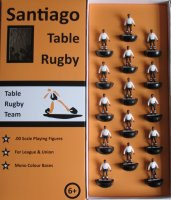
This is purely a 21st century phenomena. I think Chris Stapleton at That's Magnificent was the first out of the blocks, producing replica Subbuteo rugby bases in a wide range of colours. Pleasingly, these have recent become available again at the Santiago website.
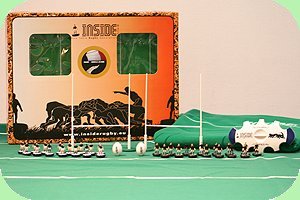
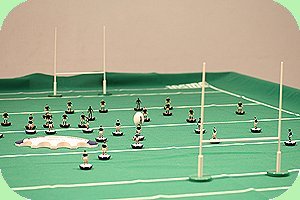
The Belgian Zeugo licensee did attempt to produce an Inside rugby box set, but this didn't make it to retail. I've been told that about 50 (or 100?) of these were made, featuring France and New Zealand. Hopefully the pictures give a feel of the game. There was a redesigned scrummer, and a ball that is bigger than Subbuteo rugby, and seems to work differently. The heavy flat bases of Zëugo seem well suited to a rugby game. I wonder what this would have played like?


However, an actual full edition of a rugby clone has arrived in the last few years. This is produced by Italian replica heavyweight sellers Top Spin. As you can hopefully see, this has the pitch, teams, posts, balls, and a kicking wedge. It doesn't seem to recreate the legendary scrummer, but these unbreakable lumps of plastic are plentiful in the collecting community, so you would have no trouble sourcing one if you so desired.